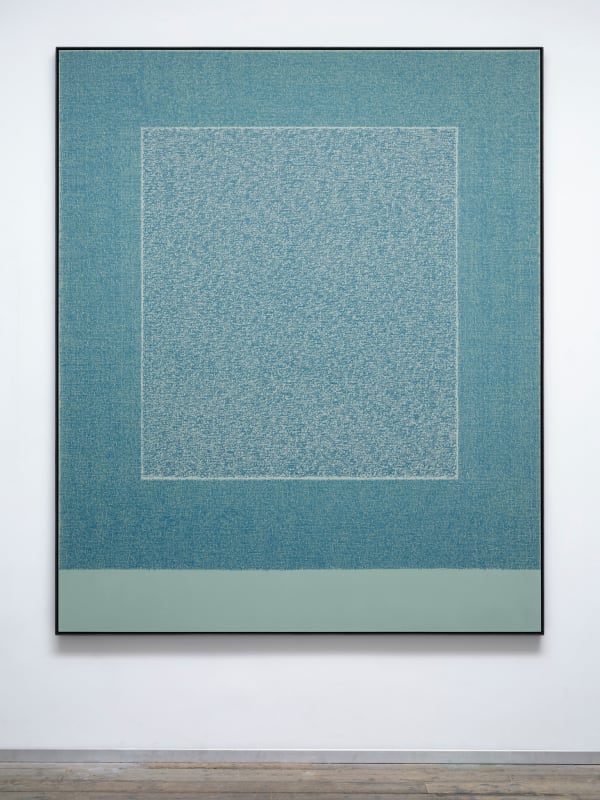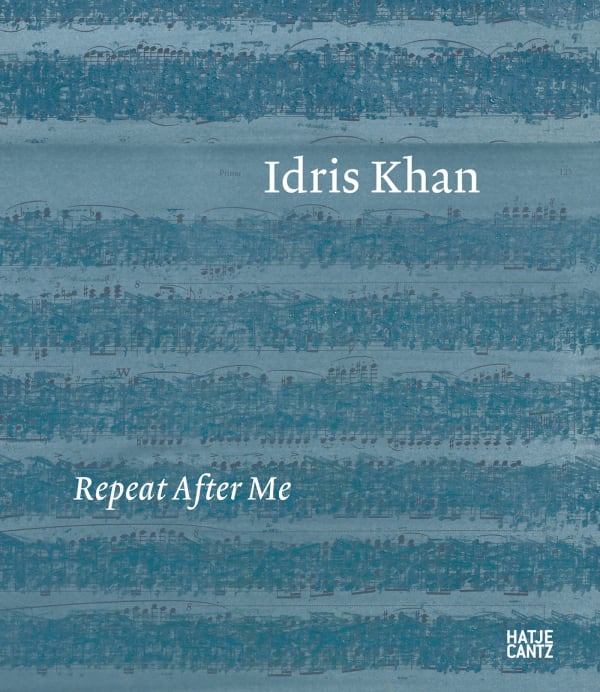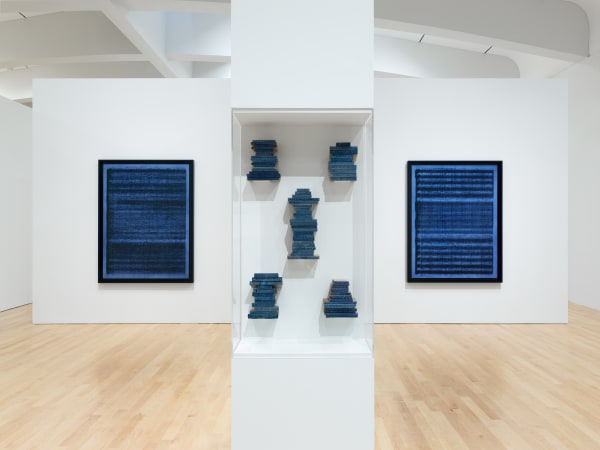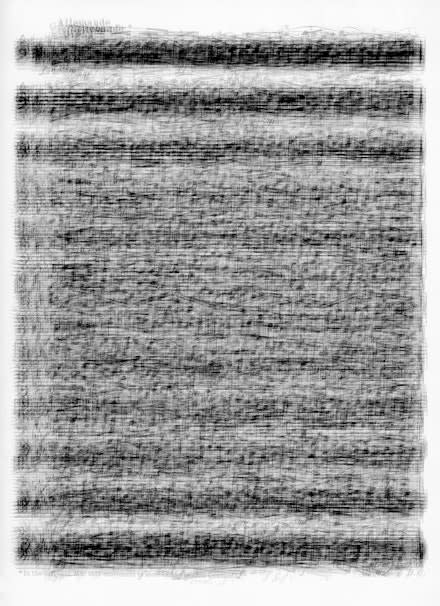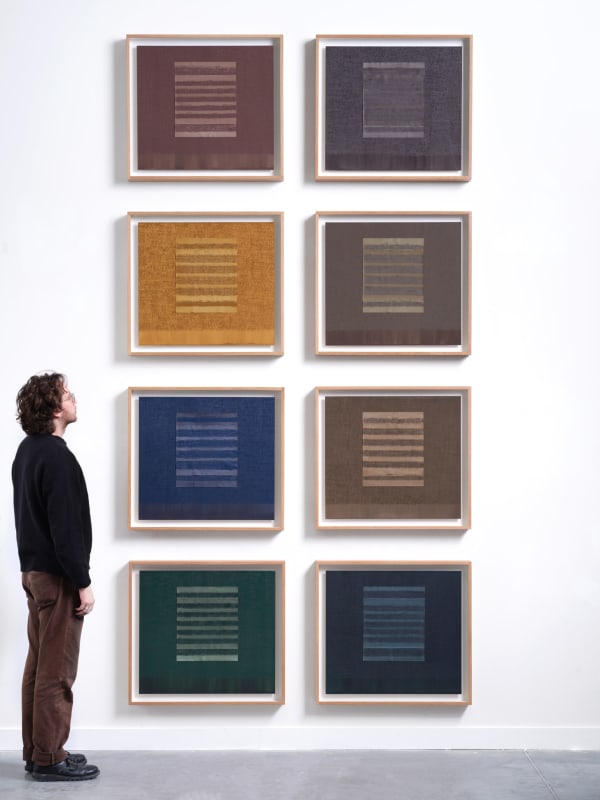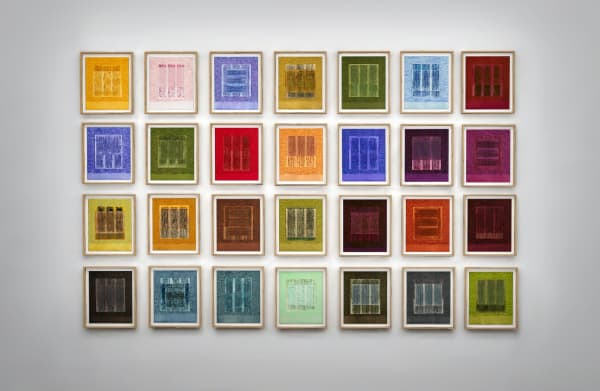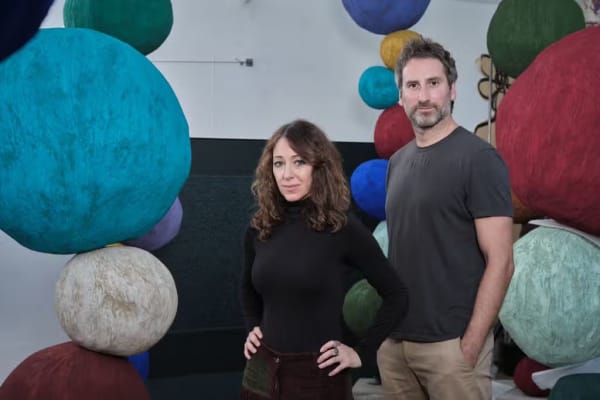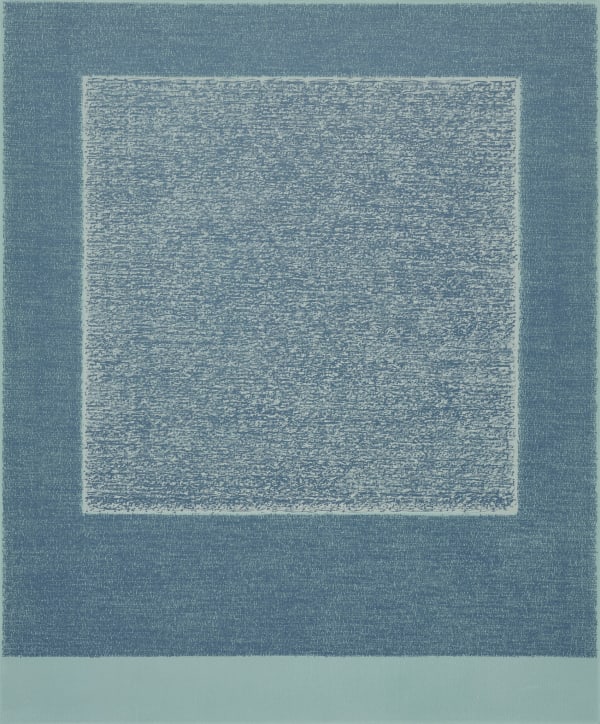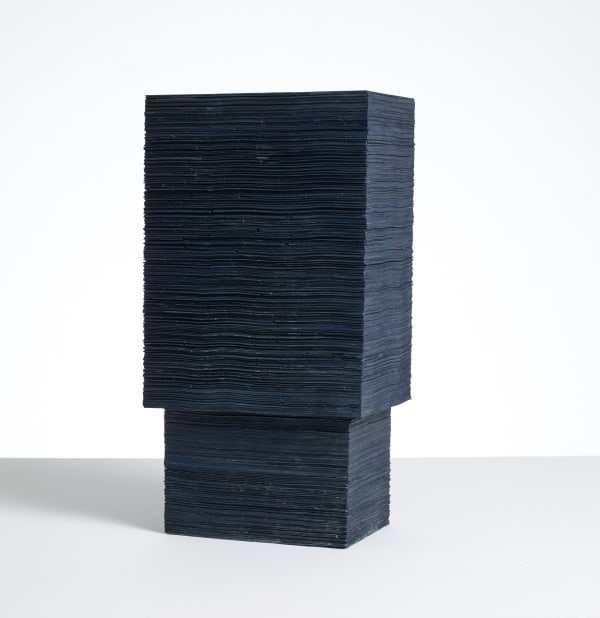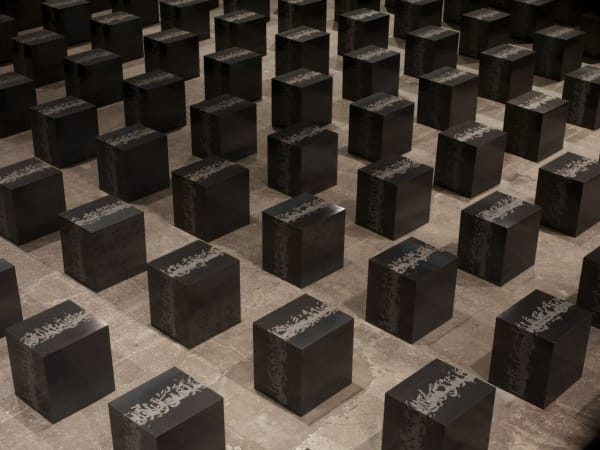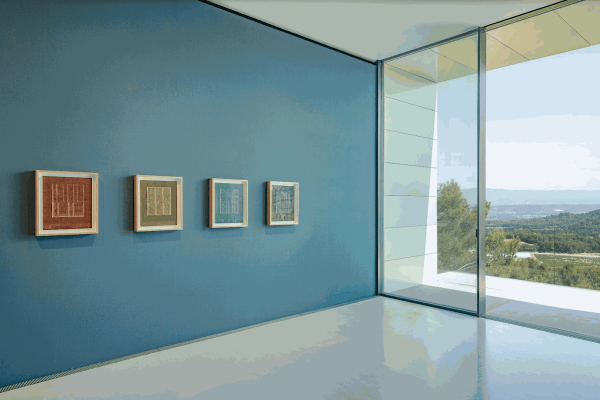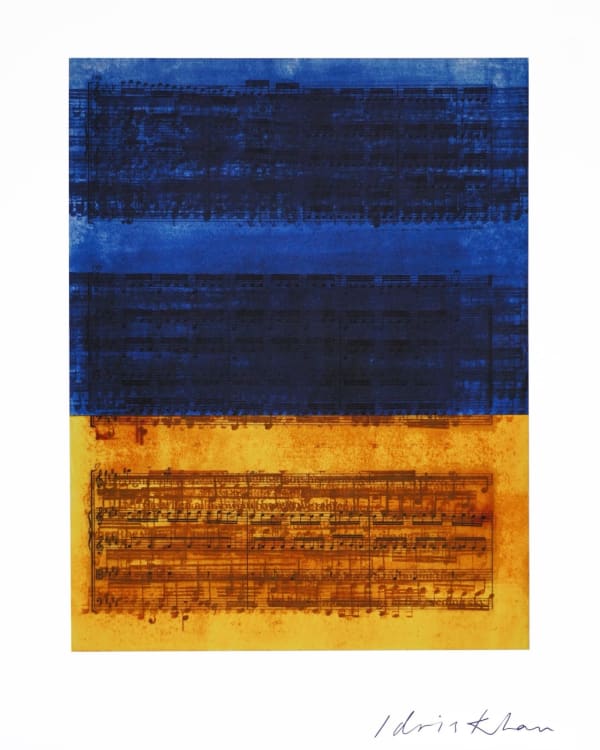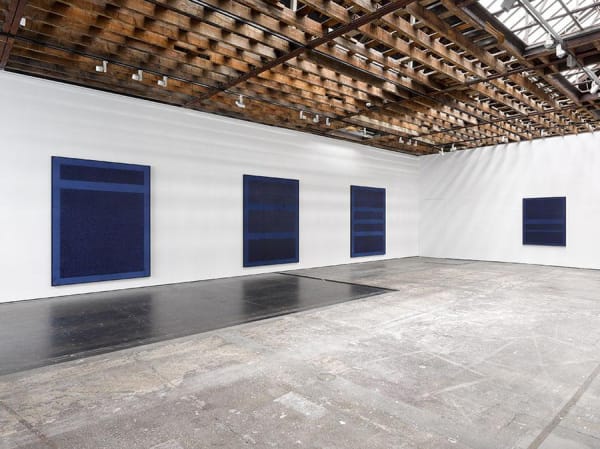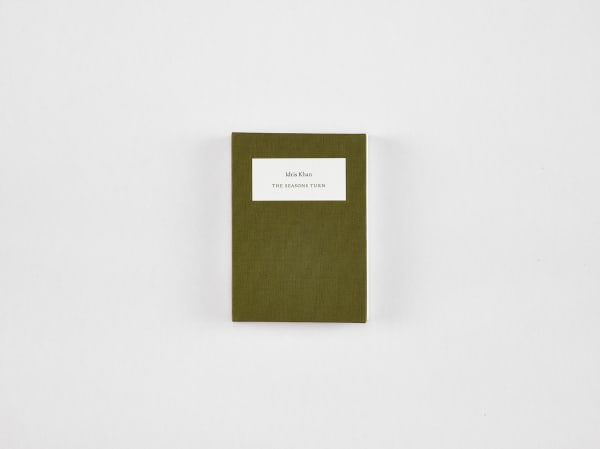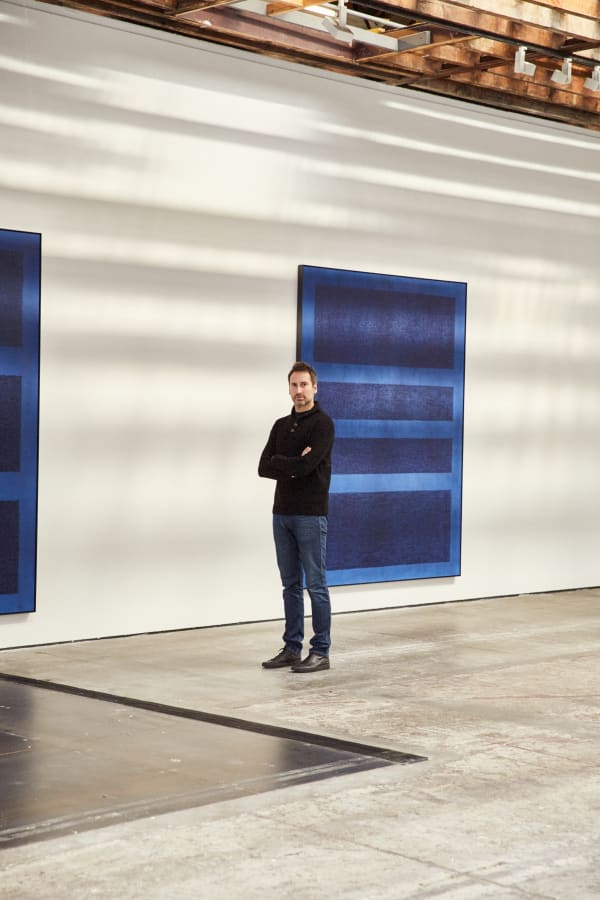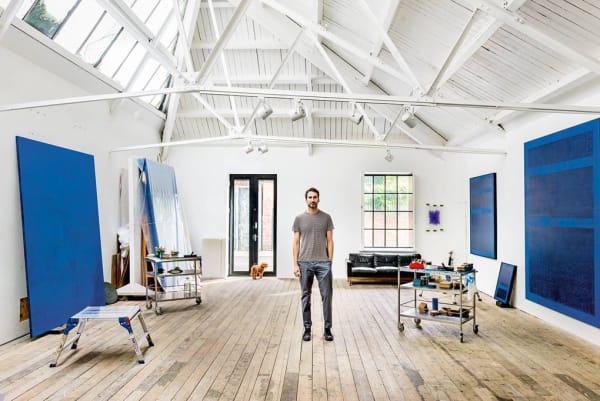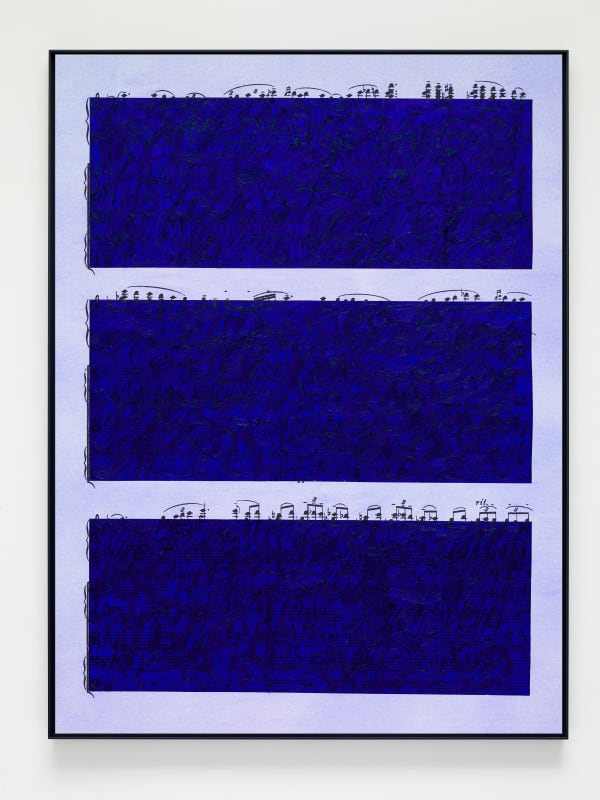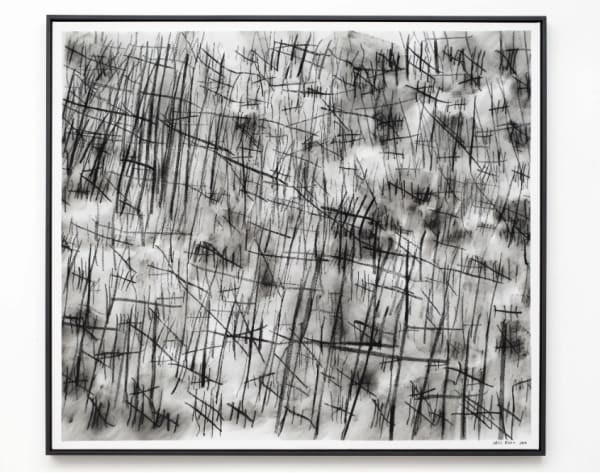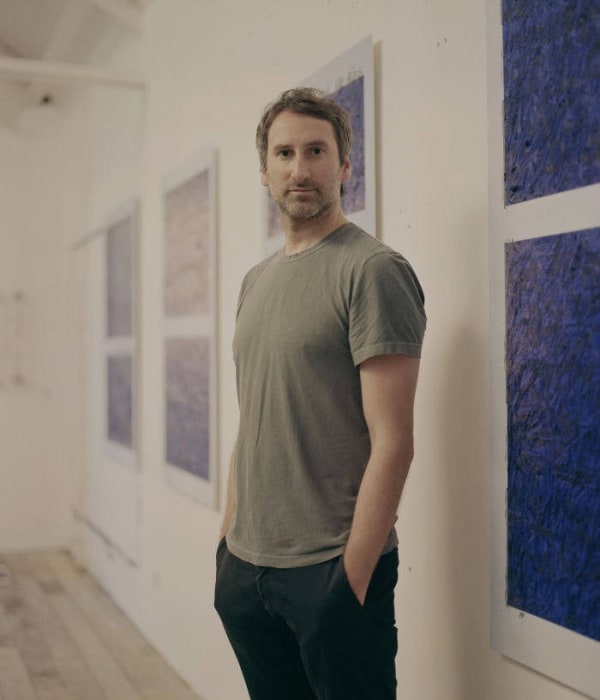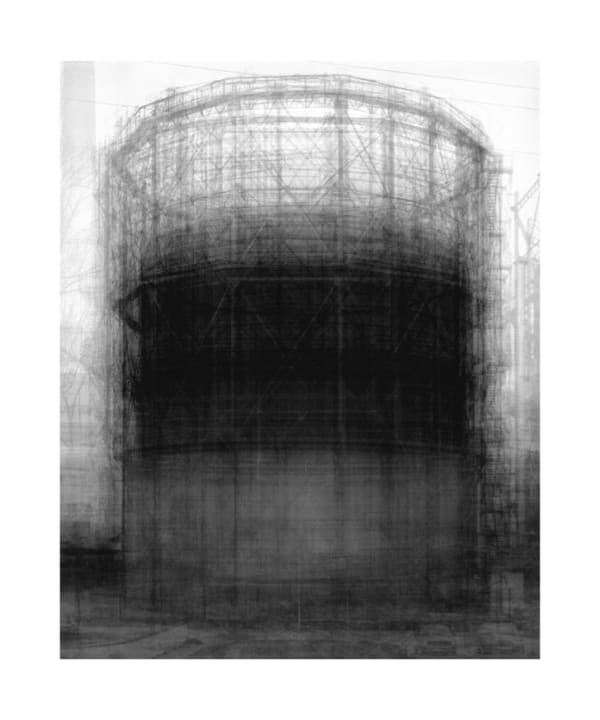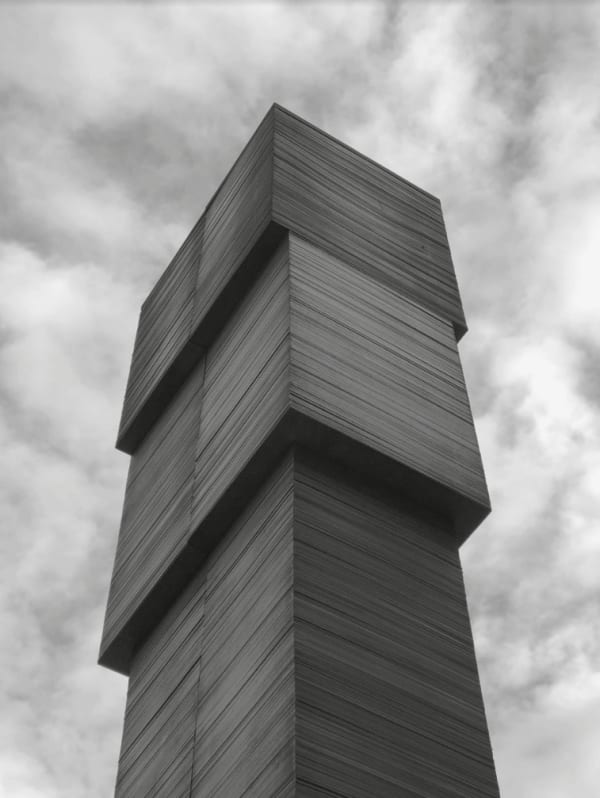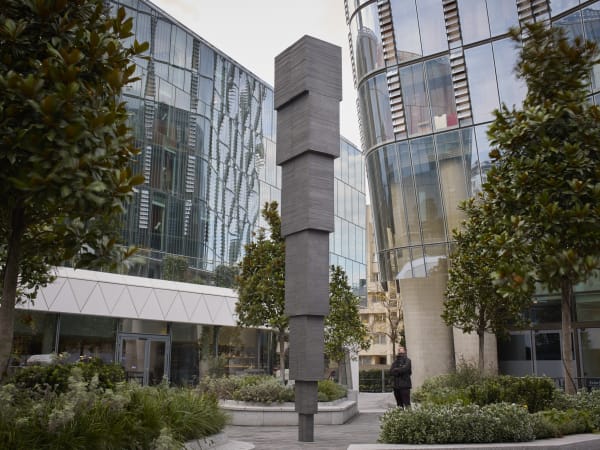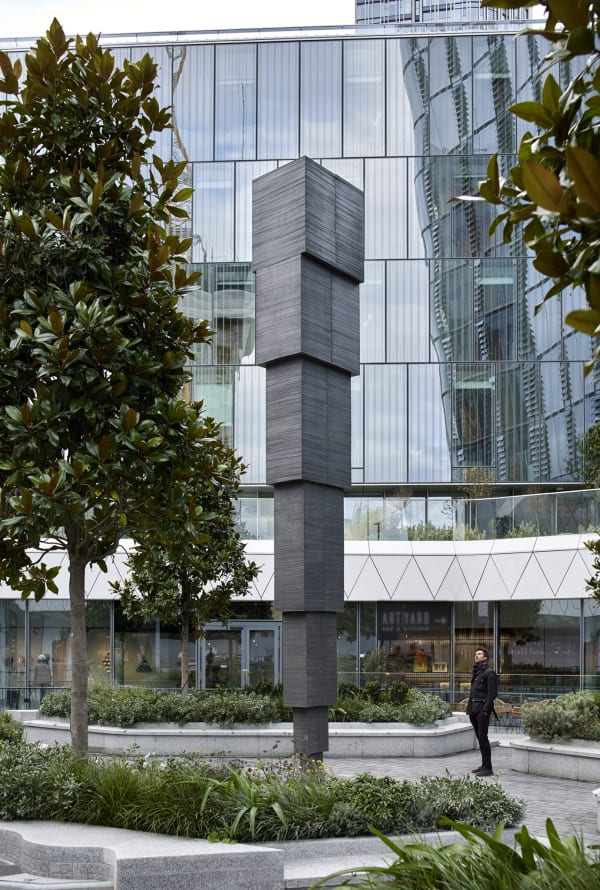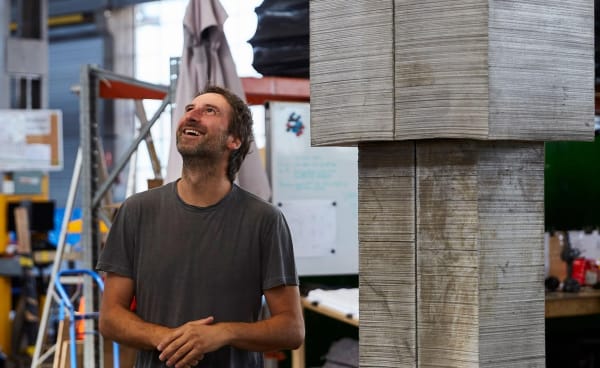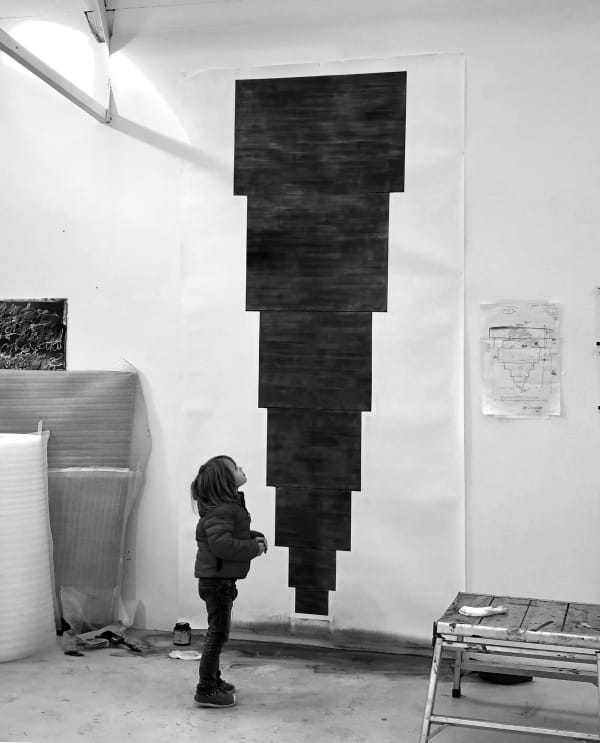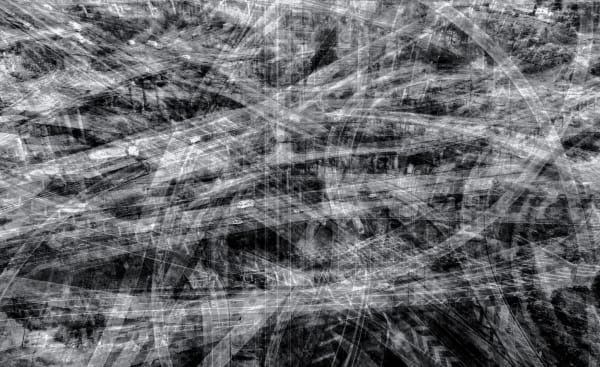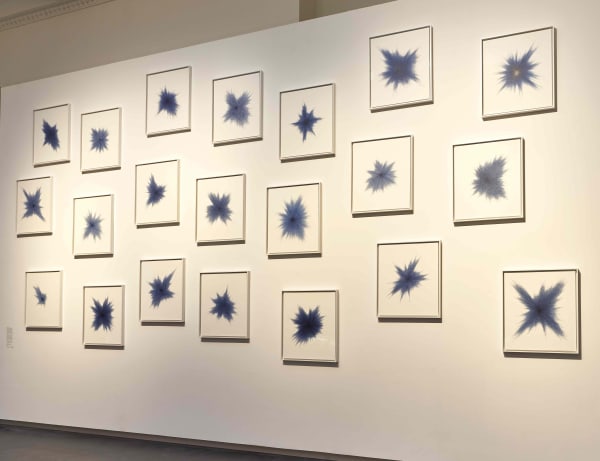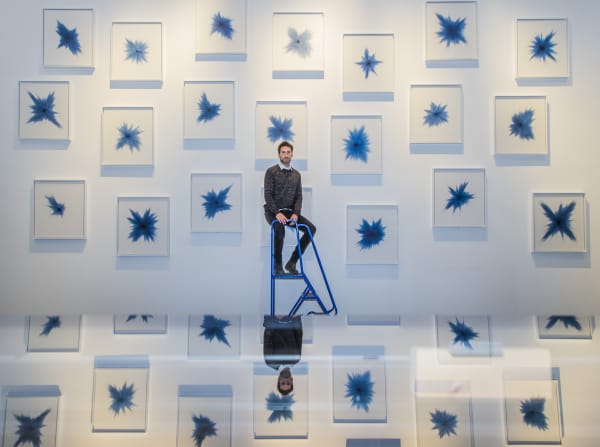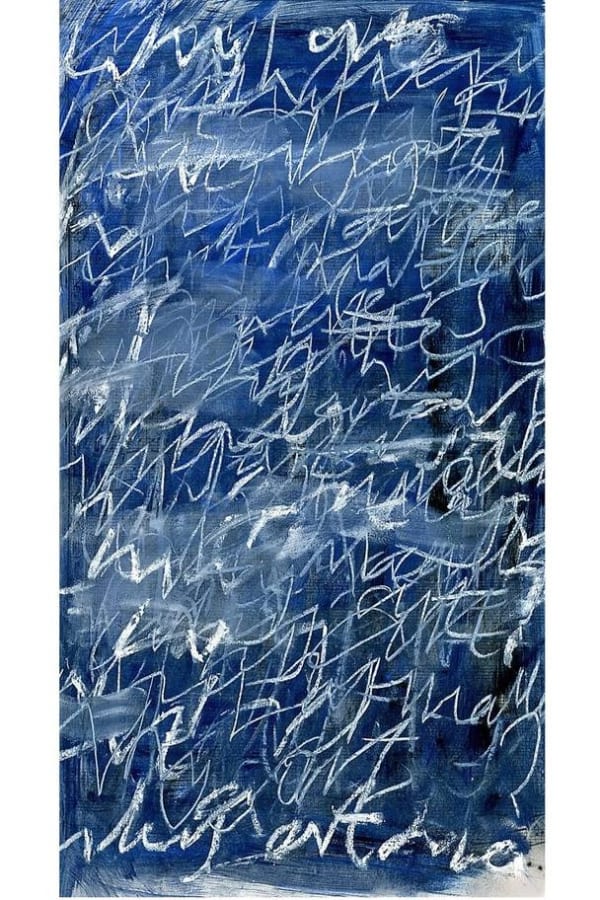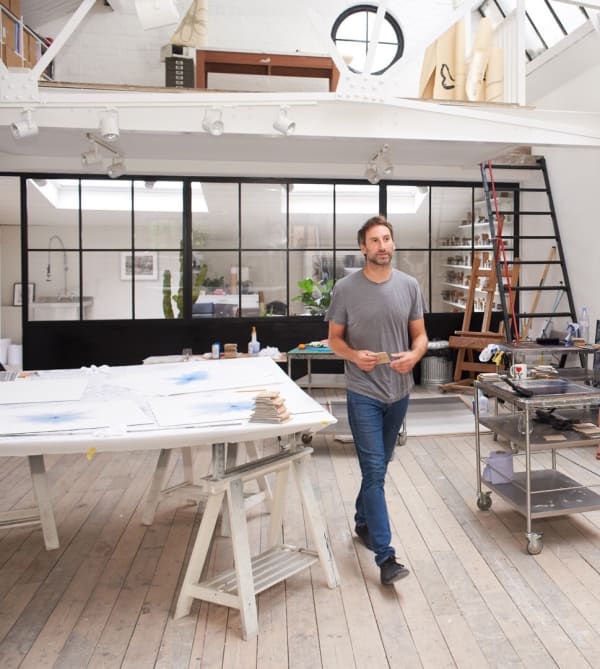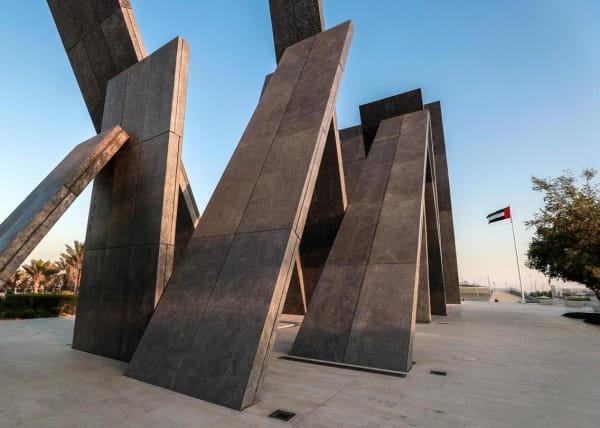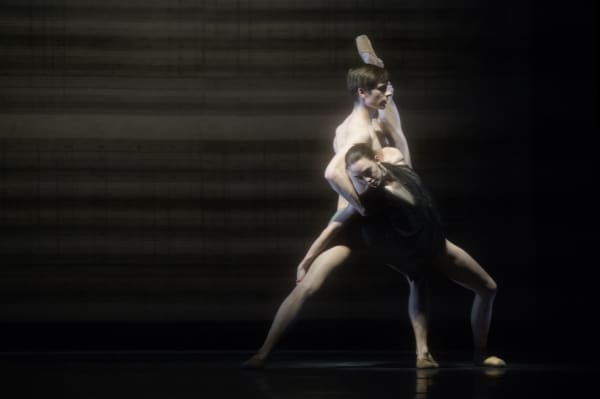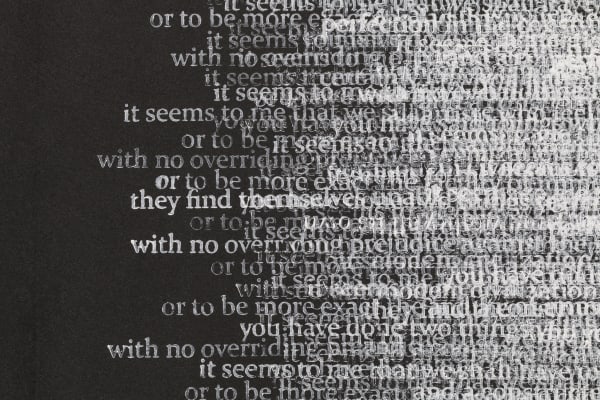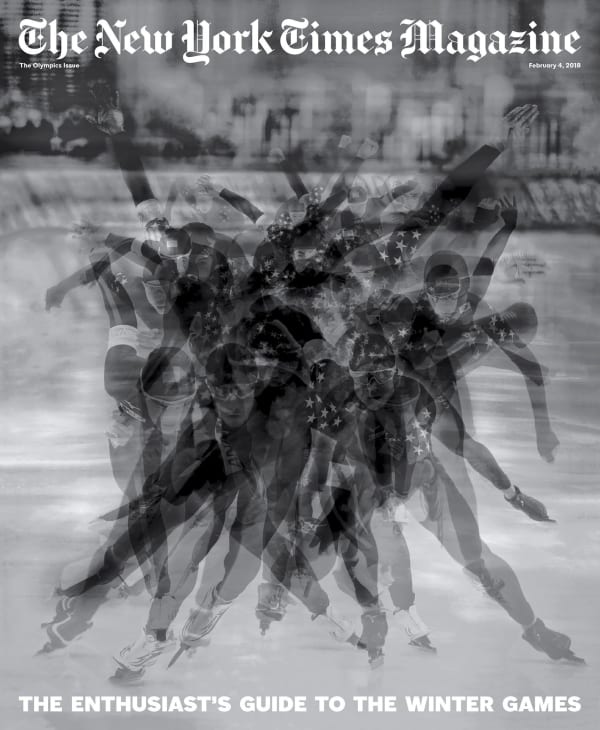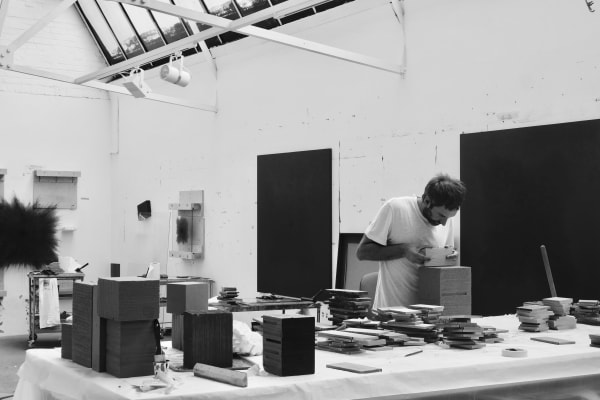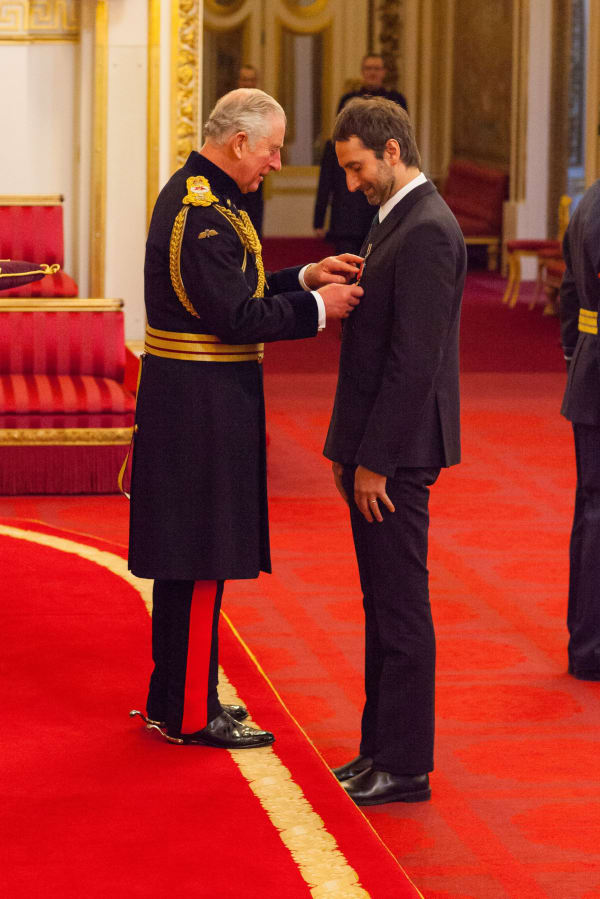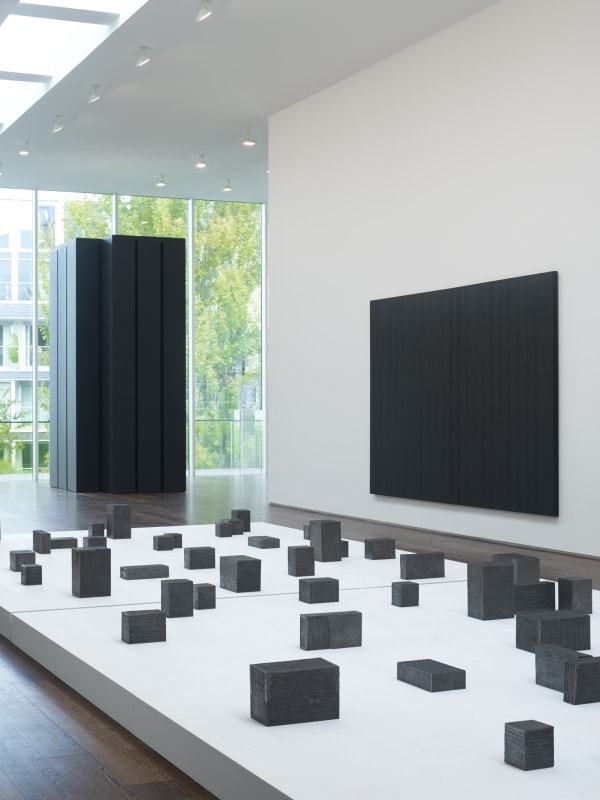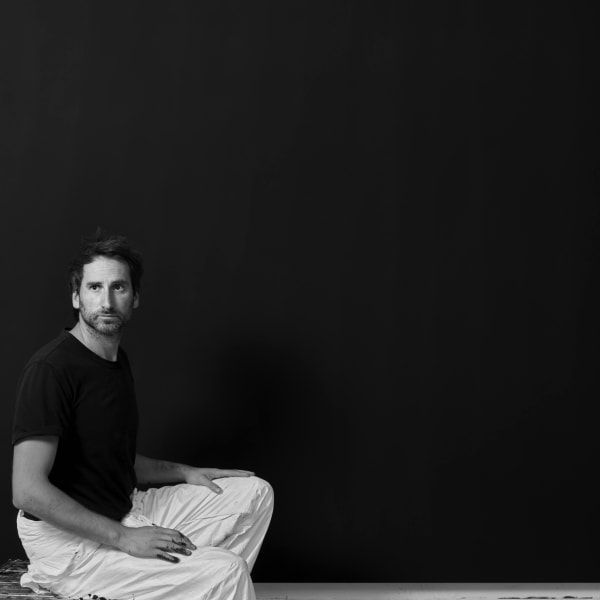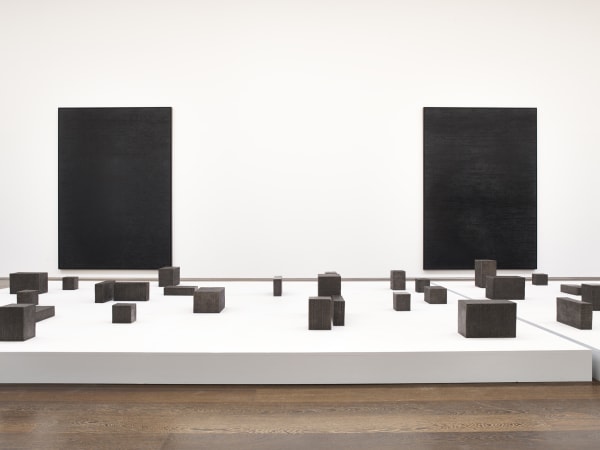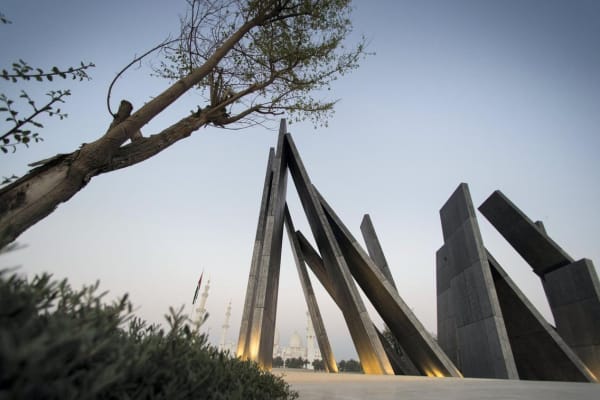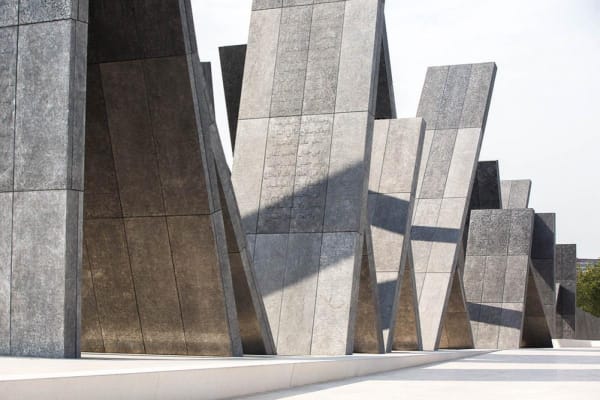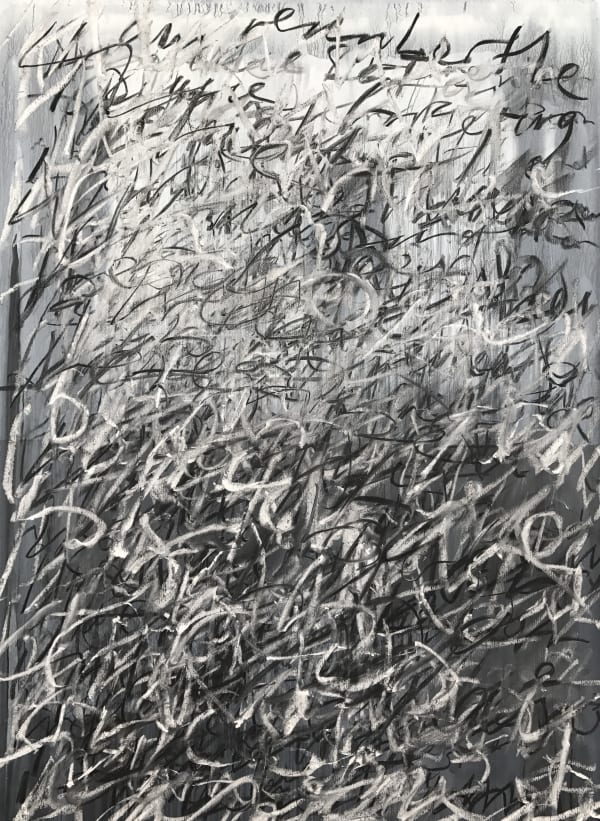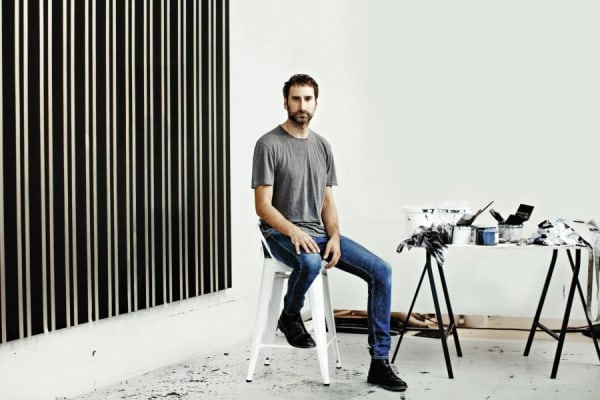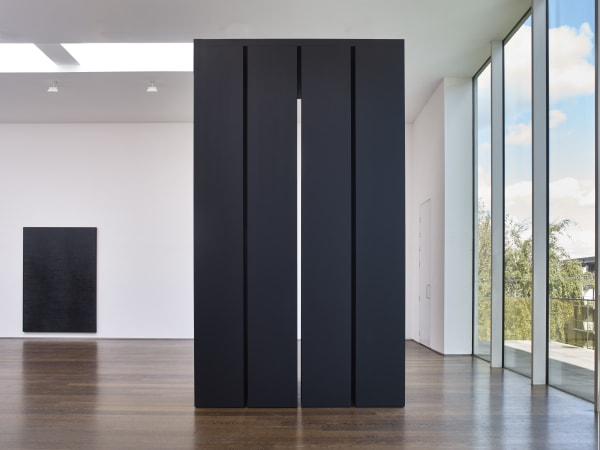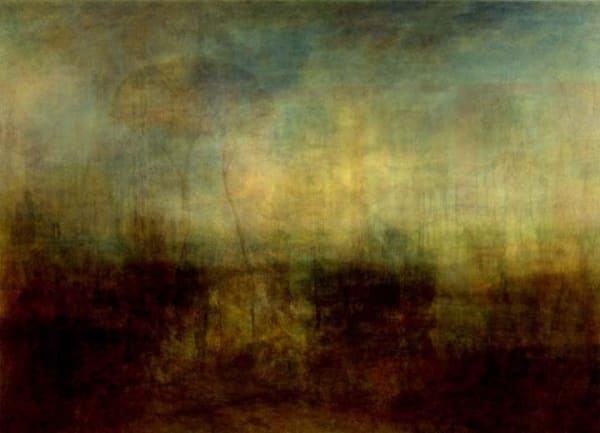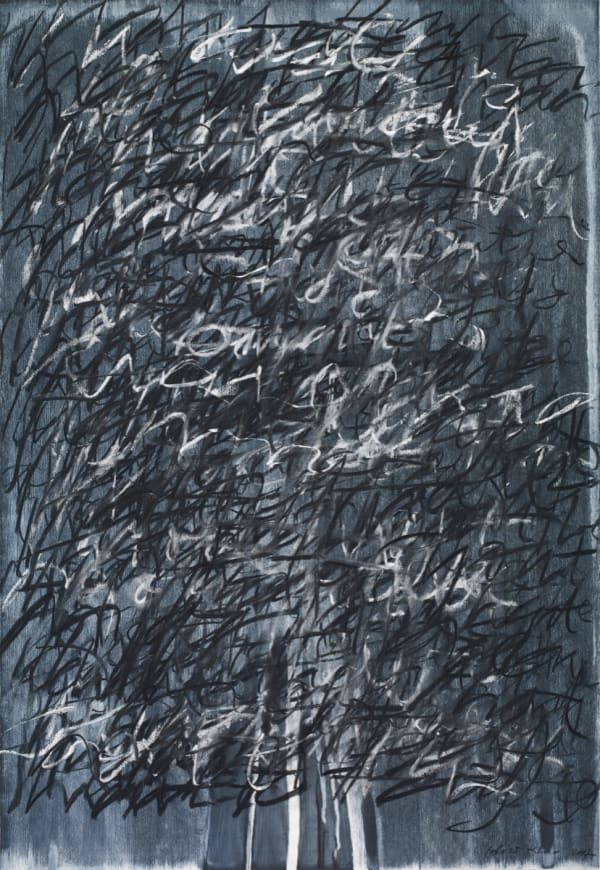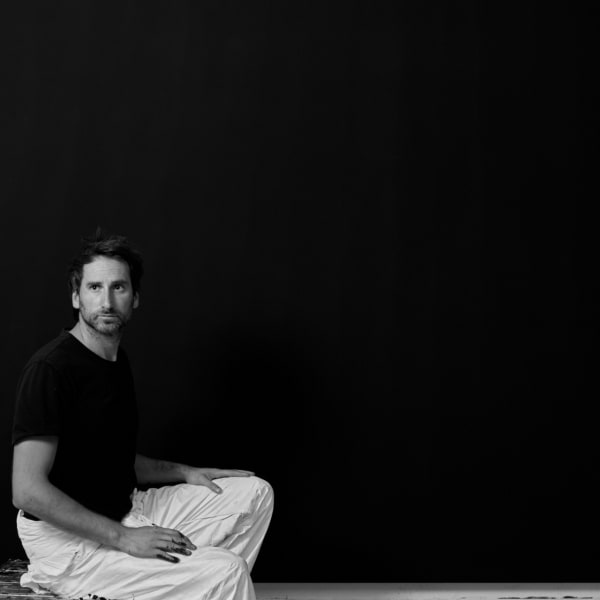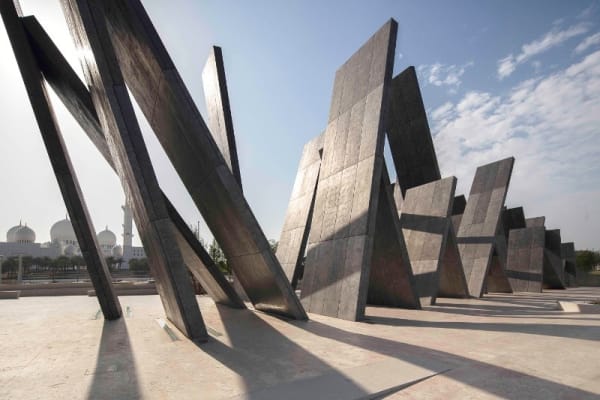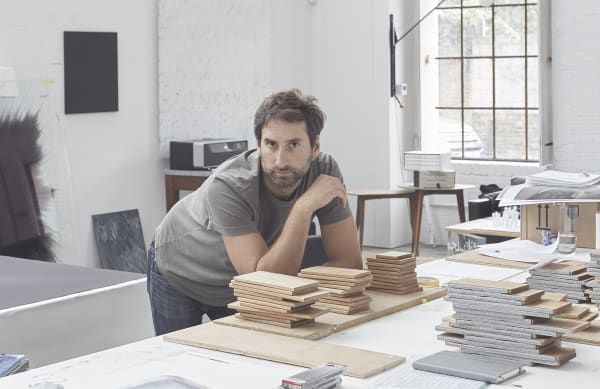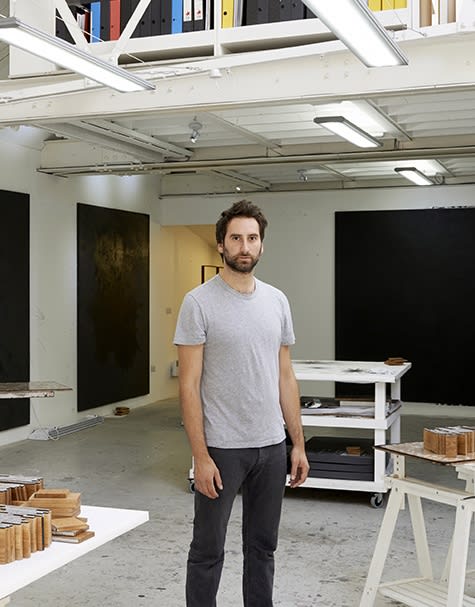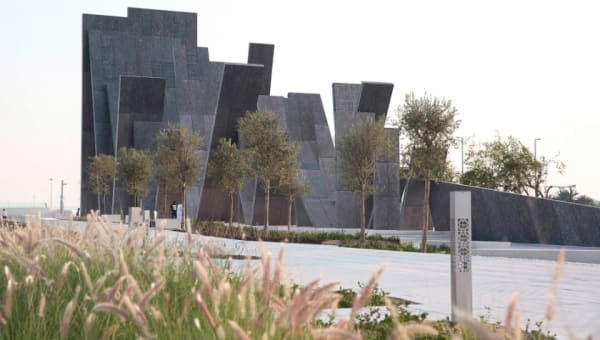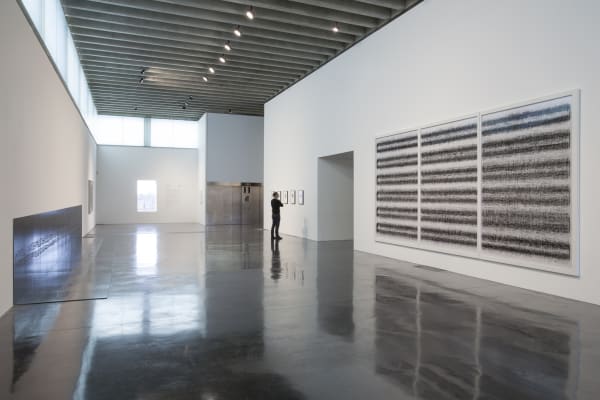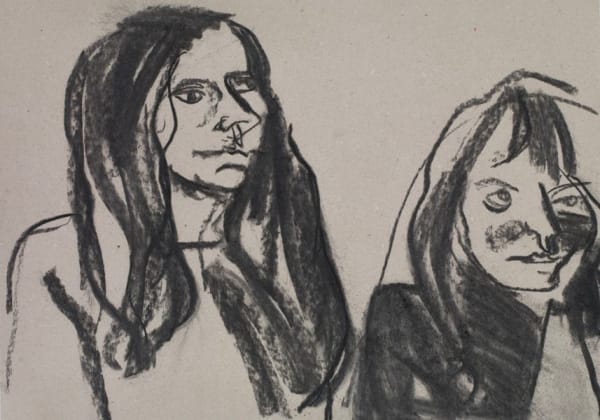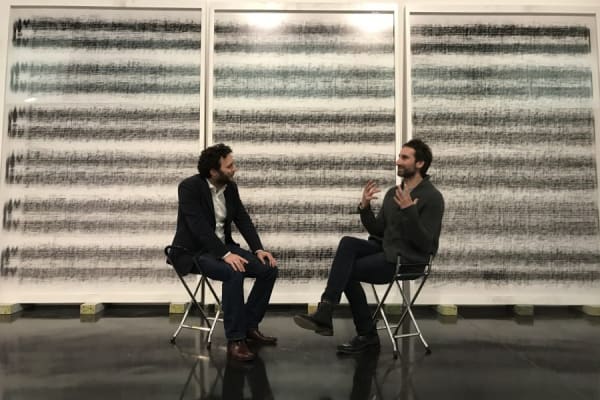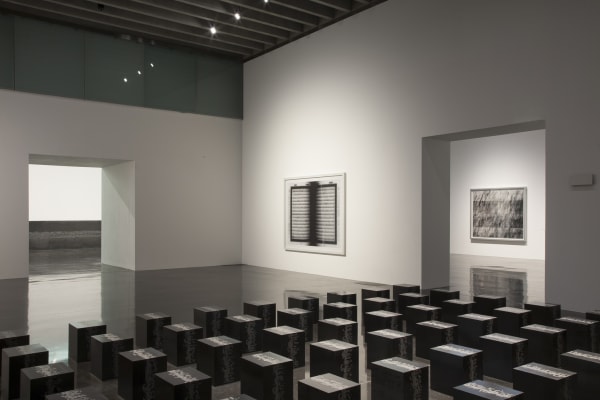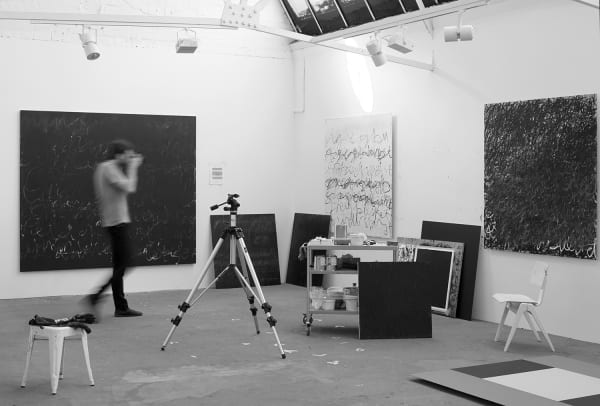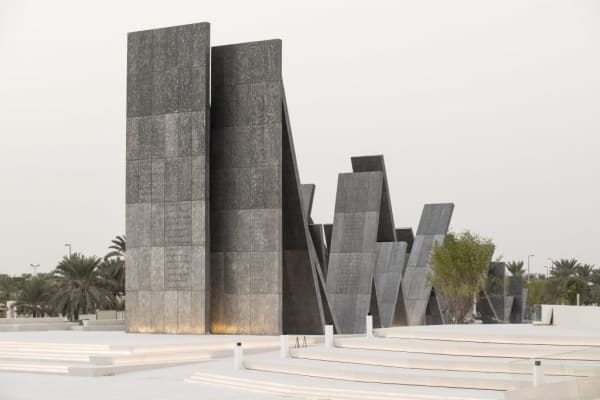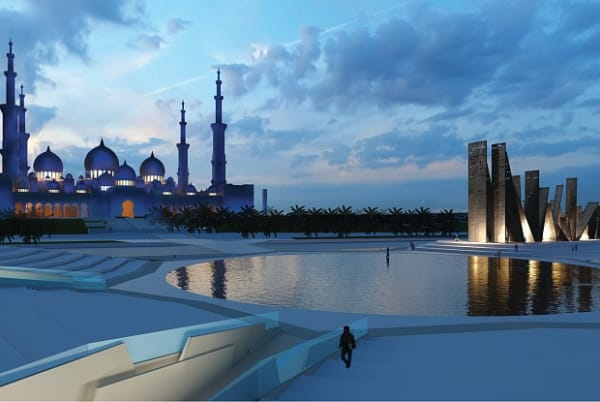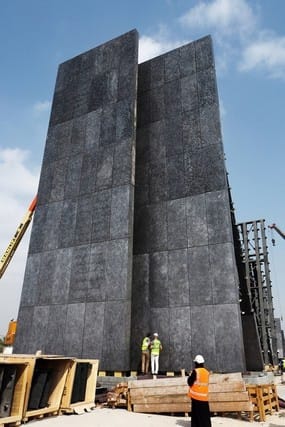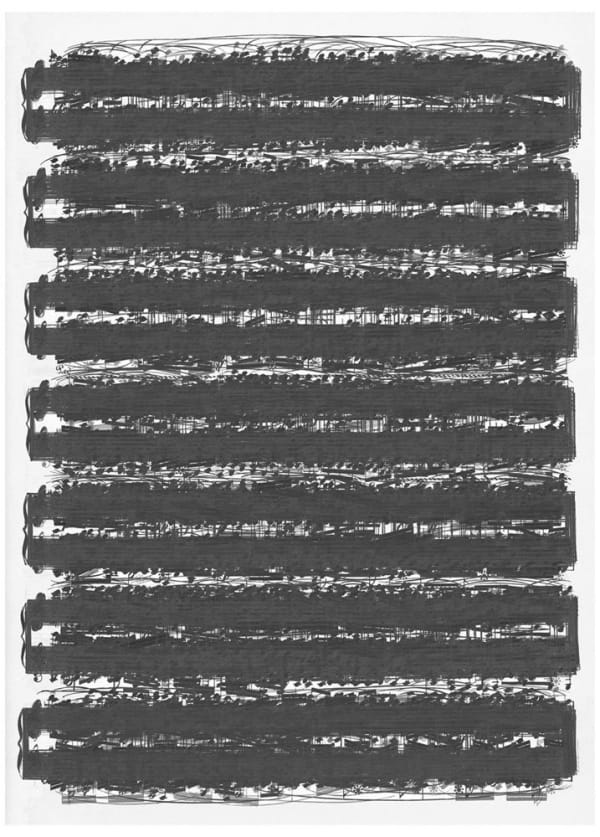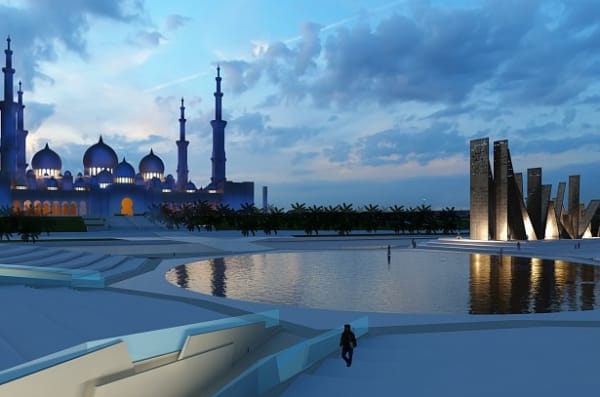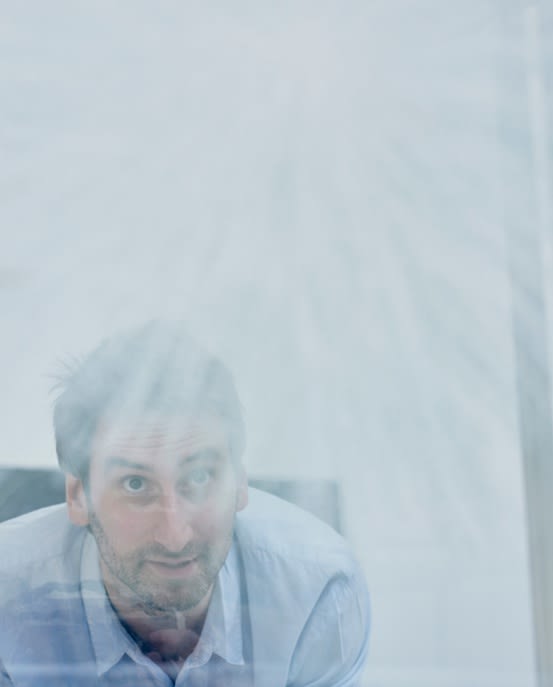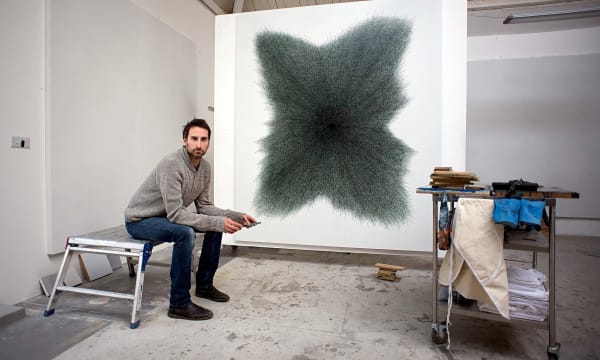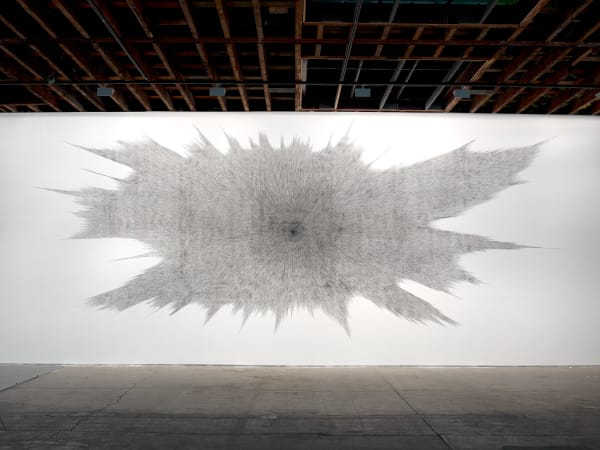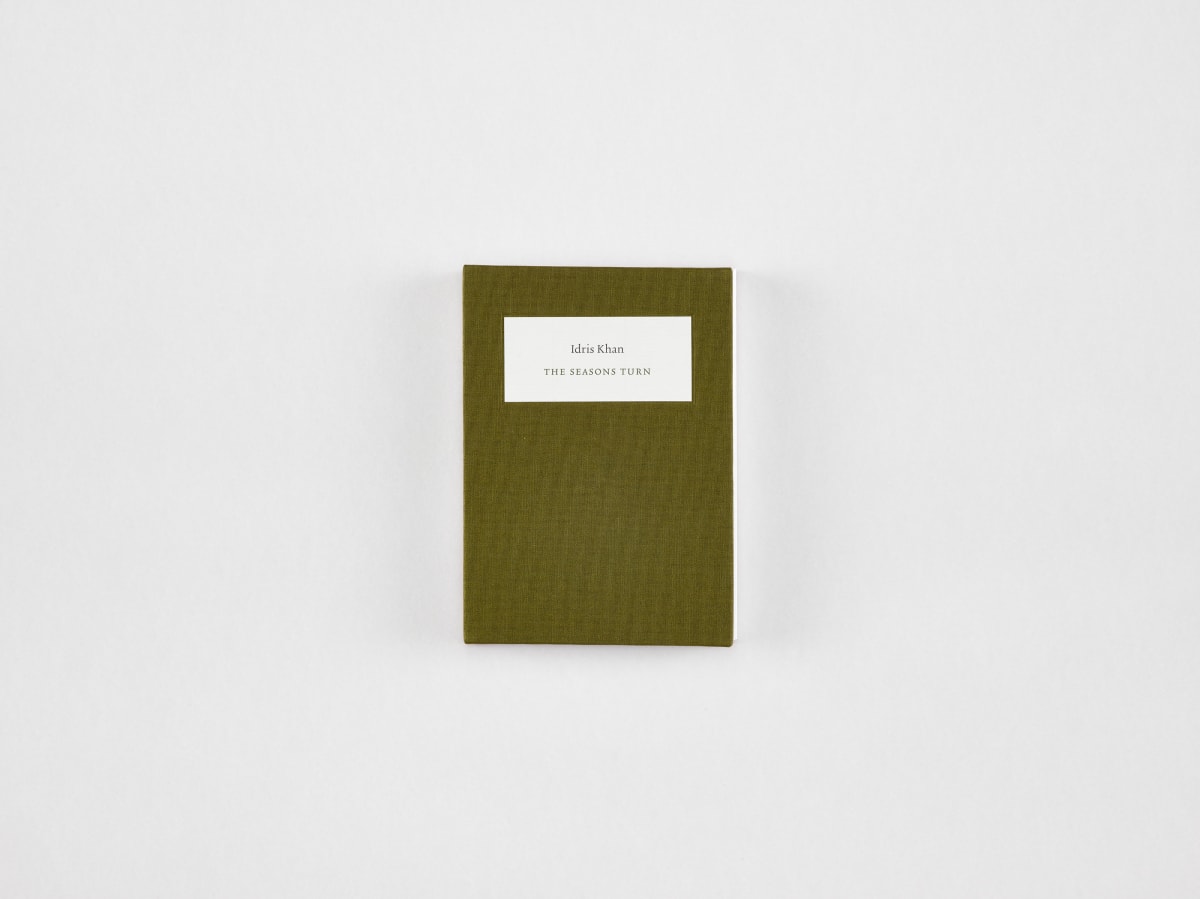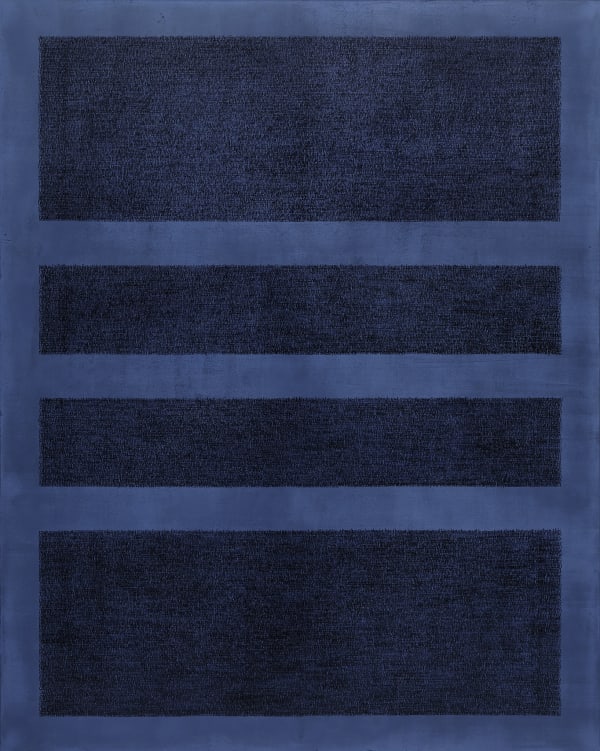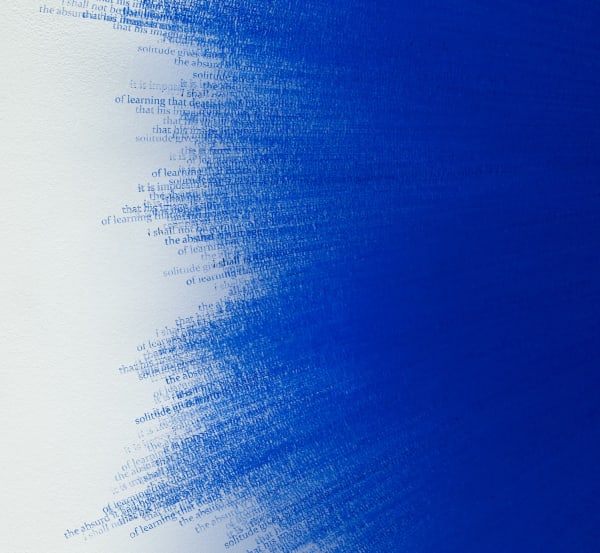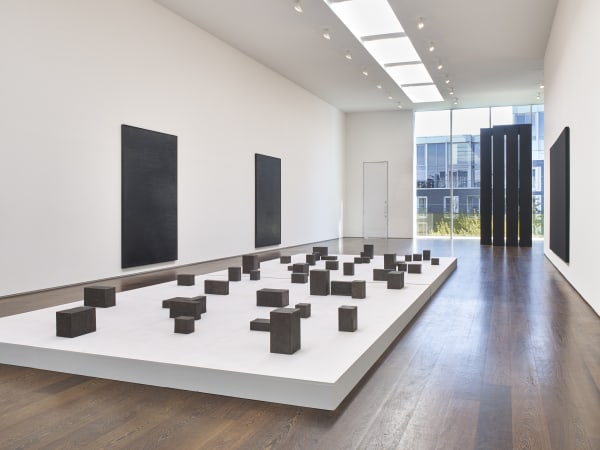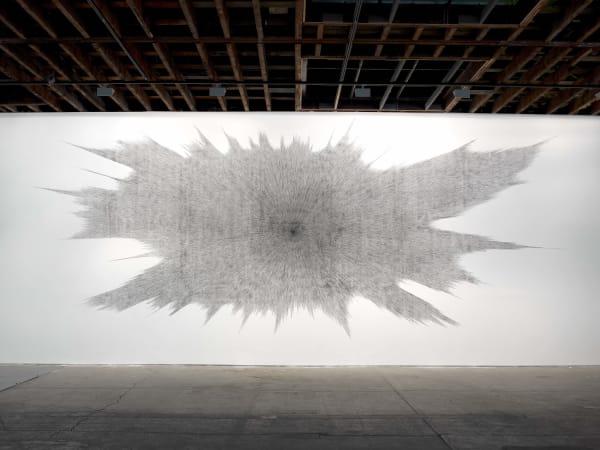Idris Khan
-
About
Drawing inspiration from the history of art and music as well as key philosophical and theological texts, Idris Khan investigates memory, creativity and the layering of experience. Khan's works – in media including sculpture, painting and photography – rely on a continuous process of creation and erasure, or the adding of new layers while retaining traces of what has gone before. He is celebrated for works in which techniques of layering are used to arrive at what might be considered the essence of an image, whereby something entirely new is created through repetition and superimposition.
While earlier works drew on pre-existing cultural artefacts and were about creating a totality from discrete parts, more recent series introduce another layer of mediation and are resolutely hand-made. Often taking many weeks to create, the results consist of many strands of text drawn from the artist's own writings in response to classic art historical, philosophical and religious tracts. These texts have profound resonance for the artist and describe his approach to creating work. However, for the viewer their full meaning is elusive. Khan suggests that our linear experience of time and place has a more shadowy relationship with memory and the subconscious, one that cannot be so easily grasped.
It is in this contemplative space that both the processes of Minimalist art and allusions to the role of repetition in the world’s major religions are brought into focus – as a vehicle for transcendence and a conduit of the sublime.
-
Biography
Born in Birmingham in 1978, Idris Khan completed his Master’s Degree at the Royal College of Art and lives and works in London.
He was appointed OBE for services to Art in the Queen’s Birthday 2017 Honours List. Khan’s first career survey exhibition in the United States, Idris Khan: Repeat After Me, was held at the Milwaukee Art Museum, Wisconsin, USA, in 2024.
Further survey exhibitions include Idris Khan: A World Within, held at The New Art Gallery Walsall in 2017, with solo presentations of the artist’s work previously staged at national and international institutional venues including the British Museum, London, UK (2018); Whitworth Gallery, University of Manchester, UK (2016–17, 2012); Sadler’s Wells, London, UK (2011); Gothenburg Konsthall, Sweden (2011); Museum of Contemporary Canadian Art, Toronto, Canada (2010); Kunsthaus Murz, Mürzzuschlag, Austria (2010) and K20, Düsseldorf, Germany (2008). His work has also been included in group shows at the Pitzhanger Manor & Gallery, London, UK (2023); Newlands House Gallery, Petworth, UK (2023); Kunstmuseum, Bonn, Germany (2021); Kunsthistorisches Museum, Vienna (2020); Royal Academy, London, UK (2019, 2018); The Whitworth, Manchester (2019); Kettle’s Yard, Cambridge (2018); New Art Gallery Walsall, UK (2017); Saatchi Gallery, London, UK (2017); Musée de L'Elysée, Lausanne, Switzerland (2016); National Gallery of Art, Washington, US (2015); Bass Museum of Art, Miami, US (2014–15); Tel Aviv Museum of Art, Israel (2014); Jeu de Paume, Paris, France (2013); Museum of Contemporary Art, Jacksonville, Florida, US (2013); The British Museum, London, UK (2012); National Museum of Contemporary Art, Oslo, Norway (2012); Fundament Foundation, Tilburg, The Netherlands (2011); Solomon R Guggenheim Museum, New York, US (2010); and Martin-Gropius Bau, Berlin, Germany (2009).
A major public sculpture for London by Khan, commissioned by St George’s Plc with London Borough of Southwark as part of the development of One Blackfriars, was unveiled in autumn 2019. In 2016, Khan was commissioned to make a permanent public monument, forming the centrepiece of the new Memorial Park in Abu Dhabi, which was unveiled on the UAE Commemoration Day. In 2017, it received an American Architecture Prize, a World Architecture News Award and a German Design Award. Further commissions include a wall drawing commissioned by the British Museum in 2012 for its exhibition Hajj: Journey to the Heart of Islam. In addition, for the duration of the exhibition, Khan’s monumental floor installation, Seven Times, was installed in the museum’s Great Court. Also in 2012, The New York Times Magazine commissioned Khan to create a new body of work for its London issue. Focusing on the capital’s most iconic buildings and structures, Khan’s image of the London Eye featured on the cover. Created in 2018 for The Albukhary Foundation Islamic Gallery, Khan's 21 Stones was the British Museum's first site-specific artwork.
Khan has also worked on significant collaborations across art forms. In 2014 he worked with choreographer Wayne McGregor and composer Max Richter on Richter’s recomposition of The Four Seasons, producing sets for the production which premiered at Zurich Opera House. Lying in Wait, 2009, a collaboration by Khan and choreographer Sarah Warsop in association with Victoria Miro and Siobhan Davies Dance, is formed of layered movement that travels between three screens.
-
News
-

New publication – Idris Khan: Repeat After Me
December 10, 2024Published by Hatje Cantz with texts by David Carrier and Marcelle Polednik , this new book is a comprehensive journey through two decades of artistic...Read More -

Idris Khan is interviewed by BOMB Magazine
July 31, 2024The artist reflects on themes that unite the works in his first US solo museum exhibition, on view at Milwaukee Art Museum until 11 August 2024.Read More -

Idris Khan: Repeat After Me is reviewed by The Brooklyn Rail
May 29, 2024‘There’s a meditative atmosphere enveloping the assembled works.’ – Tom McGlynnRead More -

Idris Khan talks to The New York Times for its Museums special section
April 26, 2024The artist discusses his first solo US museum exhibition, on view at Milwaukee Art Museum until 11 August 2024. Read more Image: Idris Khan, After...Read More -

Idris Khan: Repeat After Me at the Milwaukee Art Museum
March 28, 2024The exhibition (5 April–11 August 2024) chronicles the development of the artist’s practice across more than two decades, from early monochromatic photographic works that capture...Read More -

María Berrío, Idris Khan, John Kørner and Tal R create new works for From the Ashes
February 21, 2024Organised by Migrate Art, this fundraising exhibition and auction supports the Xingu Indigenous communities of the Amazon Rainforest. All works have been created using ink,...Read More -

Idris Khan and Annie Morris speak to the Evening Standard
October 4, 2023Read More -

Idris Khan & Annie Morris: When Loss Makes Melodies at Pitzhanger Manor & Gallery
September 28, 2023On view from 4 October 2023, a two-person exhibition engaging in a poignant dialogue with the Manor's neo-classical architecture, designed by Sir John Soane. Showcasing...Read More -

The World of Interiors reviews Two Worlds Entwined: Annie Morris and Idris Khan
February 23, 2023‘This configuration captures the harmony between their lives, while also revealing points of conflict in their artistic relationship.’ Donna Salek looks at the exhibition on...Read More -

Now extended – Two Worlds Entwined: Annie Morris and Idris Khan at Newlands House
February 9, 2023The exhibition (now on view until 4 June 2023), featuring the artist couple’s work side by side for the first time in the UK, explores...Read More -

Just opened: Islamic Arts Biennale 2023, featuring Idris Khan
January 23, 2023In its inaugural edition (23 January–23 April 2023) the Islamic Arts Biennale brings together centuries of faith and artistic expression. The Biennale is organised around...Read More -

Chantal Joffe, Idris Khan and Conrad Shawcross create works for Cure Parkinson’s exhibition
January 10, 2023Works by Chantal Joffe, Idris Khan and Conrad Shawcross are included in Cure3 to raise funds for the charity Cure Parkinson’s . Curated by Artwise...Read More -

Idris Khan at Château La Coste
July 1, 2022Unveiled in the Richard Rogers Drawing Gallery, Idris Khan's exhibition (1 July–September 2022) brings together 24 new watercolours and three large paintings on the theme...Read More -

FAD Magazine reports on Idris Khan at Château La Coste
June 22, 2022This Summer Château La Coste will be exhibiting the first solo exhibitions in France by British artists Mary McCartney, Idris Khan and Annie Morris (opening...Read More -

I Thought We Had More Time..., a ten-day timed edition by Idris Khan to raise funds for Ukrainian humanitarian causes
March 21, 2022Having first collaborated in 2019 to raise money for refugees in Europe, Idris Khan and Migrate Art are working together to raise funds for the...Read More -

Frieze reviews Idris Khan’s recent exhibition The Seasons Turn
May 24, 2021Conceived as two distinct installations at Victoria Miro, ‘The Seasons Turn’ sees Khan’s continued engagement with the devotionality of repetition, while venturing tentatively into colour....Read More -

Now available: Idris Khan The Season’s Turn – an artist’s book
May 10, 2021This beautifully designed artist's book, with a cloth-bound double cover, concertinas to reveal Idris Khan's work The Seasons Turn, with spring and summer on one...Read More -

Apollo: In the studio with… Idris Khan
April 20, 2021From his early composite photographs to more recent paintings and sculptures, Idris Khan’s work frequently employs techniques of layering and repetition – of images, texts,...Read More -

Listen to Idris Khan on How to be an artist
April 12, 2021Idris Khan joins Kate Bryan on How to be an artist , the new podcast by Soho House. How To Be An Artist features some...Read More -

Idris Khan on BBC Front Row: The Blue Edition
April 2, 2021This edition of Front Row is a blue odyssey led by John Wilson as he talks to, among others, Idris Khan, who discusses his work...Read More -

House & Garden take a look inside Idris Khan’s London studio
February 3, 2021‘I was a suburban lad from Birmingham who moved to London,’ says Idris Khan, explaining how spending six months in the Sussex countryside during lockdown...Read More -

Wallpaper* selects Victoria Miro’s Idris Khan presentation as one of its Frieze LA highlights
February 13, 2020At Victoria Miro’s booth (B11) , British artist Idris Khan is intent on hitting all the high notes at Frieze with a meditative display of...Read More -

Victoria Miro participates in Frieze LA with a solo presentation by Idris Khan
February 10, 2020 Read More -

Idris Khan creates a unique work for Fine Cell Work’s Human Touch exhibition and sale
February 7, 2020This exhibition (Sotheby's, London, 26 February-3 March 2020; bidding from 12 February 2020) and sale of works a ground-breaking collaboration between international contemporary artists and...Read More -

Idris Khan is profiled in the Financial Times ahead of his solo presentation with Victoria Miro at Frieze LA
February 7, 2020Idris Khan is riding the crest of a wave. Still only 41, the British contemporary artist has been displayed in institutions including the British Museum...Read More -

Coming soon – Time Present: Photography from the Deutsche Bank Collection, featuring Idris Khan
February 5, 2020The exhibition (21 March 2020–8 February 2021) presents a broad spectrum of international photography collected by Deutsche Bank over the course of four decades. Read...Read More -

Idris Khan’s public sculpture 65,0000 Photographs is officially unveiled at One Blackfriars
November 21, 2019For this towering sculpture and major public work, Khan has drawn from his personal archive of images from the past six years – some 65,000...Read More -

Idris Khan talks to the British Journal of Photography as his new public sculpture, 65,000 Photographs, goes on view in London
November 18, 2019Every day, more than 1.8 billion photographs are uploaded online. This works out to just over 1.25 million images per minute or 20,000 per second....Read More -

Idris Khan talks to Robert Elms for Listed Londoner
November 11, 2019 Read More -

Idris Khan talks to Wallpaper* about 65,0000 Photographs, a new public sculpture for London
November 4, 2019Idris Khan’s first UK public sculpture addresses our photo-obsessed culture Referring to his personal archive of some 65,000 photographs, the London-based artist has created a...Read More -

Chantal Joffe, Idris Khan, Grayson Perry and Conrad Shawcross donate works to Willow Foundation’s The Extraordinary Collection
August 7, 2019Works are available to view at a public exhibition at Coutts, The Strand (23-27 September 2019) and will be sold on behalf of Willow, a...Read More -

A major new public sculpture for London by Idris Khan
May 3, 2019Commissioned by St George's Plc with London Borough of Southwark as part of the development of One Blackfriars, the work titled 65,000 Photographs will be...Read More -

Works by Idris Khan feature in The New York Times Magazine
January 3, 2019 Read More -

Press for Idris Khan: 21 Stones, the British Museum’s first site-specific artwork
October 17, 2018The work forms part of the new Albukhary Foundation Gallery of the Islamic World (from 18 October 2018). Khan’s 21 drawings are based on The...Read More -

Idris Khan creates the British Museum’s first site-specific work as part of the new Albukhary Foundation Gallery of the Islamic World
October 16, 2018Opening on 18 October 2018, the new gallery is a new exploration of the Islamic world through art and material culture. In response to the...Read More -

Idris Khan creates the first ever artwork for the Evening Standard’s Comment section
October 4, 2018For the first time in its history, the Evening Standard has commissioned an artwork for its Comment section. Khan has responded with a work that...Read More -

Idris Khan talks about his work as part of Art Out Loud at Chatsworth
September 18, 2018On Friday 21 September, 2:30pm–3:30pm, as part of the 2018 Art Out Loud festival, Idris Khan talks about his practice, exploring the influences and the...Read More -

Idris Khan talks to The National about creating the award-winning UAE memorial Wahat Al Karama
September 10, 2018By Melissa Gronlund Opposite Abu Dhabi’s Sheikh Zayed Grand Mosque, a series of heavy grey slabs lean against each other, as if arrested in the...Read More -

A Wayne McGregor triple bill, featuring Kairos with set design by Idris Khan, at Nationaltheater, Munich
April 11, 2018Performances by Munich's Bayerisches Staatsballett (14, 15, 18, 28 April, 11, 18 May, 12, 23 June, 10 July 2018 and dates throughout 2019) include Kairos...Read More -

Idris Khan creates a new work to mark the re-opening of Kettle’s Yard
February 6, 2018The exhibition (10 February – 6 May 2018), with work by thirty-eight artists, marks the opening of the new Kettle’s Yard and seeks to reassert...Read More -

Idris Khan creates photo illustrations for The New York Times Magazine’s Olympics issue
February 5, 2018Khan's photo illustrations featured on the cover of the Olympics Issue of The New York Times Magazine, accompanying a piece by acclaimed Norwegian writer Karl...Read More -

Tate Britain Salon, featuring Idris Khan
January 23, 201816 February 2018, 6.45-8.45pm Tickets £22 Inspired by The EY Exhibition: Impressionists in London, which tells the story of artists who fled to Britain to...Read More -

Idris Khan receives his OBE for services to Art
November 23, 2017The artist was appointed an Officer of the Order of the British Empire for services to Art in the Queen’s Birthday 2017 Honours List. He...Read More -

Studio International reviews Idris Khan: Absorbing Light
October 30, 2017Reflections on the horrors of one of Syria’s most famous prisons have driven Idris Khan to new forms of expression, including bronze sculptures and abstract...Read More -

Idris Khan, Conrad Shawcross and Grayson Perry are among the Evening Standard’s Progress 1000 celebration of London’s most influential people
October 23, 2017The artists are featured among London's Top Visualisers: Artists & Curators Idris Khan Khan, a London resident since studying at the Royal College of Art,...Read More -

The Evening Standard recommends Idris Khan: Absorbing Light in the London Art Gallery Guide
October 17, 2017By Jessie Thompson What’s the show? Absorbing Light marks an important departure for Idris Khan, who is showing works in bronze for the first time....Read More -

The National reports on Idris Khan’s receipt of a 2017 American Architecture Prize
October 11, 2017Abu Dhabi's Wahat Al Karama wins 2017 American Architecture Prize The brainchild of the British artist Idris Khan, the capital's Oasis of Dignity has been...Read More -

Idris Khan’s Monument and Pavilion of Honour for Wahat Al Karama, UAE’s Memorial Park, receives an American Architecture Prize
October 11, 2017The American Architecture Prize recognises individuals and teams who have made a substantial contribution to all areas of architecture Wahat Al Karama (Oasis of Dignity)...Read More -

Idris Khan and Isaac Julien donate works to Art For Grenfell
October 9, 2017The auction (which took place on 16 October 2017) to raise money for those affected by the Grenfell Tower fire raised £1.9million in total. Isaac...Read More -

Idris Khan interviewed in ES Magazine’s Art Issue
October 5, 2017By Patricia Nicol It is an urban adventure finding the north London studio of artist Idris Khan and his wife, Annie Morris. At Newington Green,...Read More -

Nick Compton writes about Idris Khan: Absorbing Light in Wallpaper*
October 4, 2017Idris Khan has built his reputation in multiple layers. He repeatedly scrawls or stacks images, creating hypnotic haunting palimpsests, buzzing and charged, dense with history...Read More -

Ben Luke selects Idris Khan and Tal R exhibitions for his Frieze Week highlights
September 29, 2017Tal R: Sexshops The Danish artist has depicted the façades of massage parlours and so on, whose seedy connotations are belied by the beauty of...Read More -

Idris Khan in Legacies: JMW Turner and Contemporary Art Practice at The New Art Gallery Walsall
September 22, 201722 September 2017 – 14 January 2018 A master of history, landscape and marine painting, Joseph Mallord William Turner (1775-1851) challenged accepted conventions in art,...Read More -

Idris Khan speaks to Artsy about his new work for Make-A-Wish UK’s fundraising gala
September 19, 2017Children's Make-A-Wish Dreams Inspire New Artworks by Leading Artists By Casey Lesser Six-year-old Grace yearned to go on holiday in Wales with her pony; nine-year-old...Read More -

Idris Khan included in Apollo 40 Under 40 Global
September 8, 2017Idris Khan’s works – which draw on a wide range of sources, from literature and philosophy to theology and music – often overlay multiple texts...Read More -

Idris Khan’s monument for UAE Memorial Park is shortlisted for a World Architecture Festival award
August 8, 2017Khan has been shortlisted in the Civic and Community category of the World Architectural Festival, which will be held in Berlin (15-17 November 2017). Read...Read More -

Idris Khan appointed OBE in the Queen’s Birthday 2017 Honours List
June 16, 2017Artist Idris Khan has been appointed an Officer of the Order of the British Empire for services to Art in the Queen’s Birthday 2017 Honours...Read More -

Idris Khan receives a Culture Summit Abu Dhabi 2017 award
April 10, 2017Khan is one of nine winners, including former US Secretary of State Madeleine Albright, selected for their contributions to cultural diplomacy and promoting positive change....Read More -

Architectural Digest talks to Idris Khan about his monument for UAE Memorial Park
April 7, 2017British artist Idris Khan designs first memorial dedicated to Emirati soldiers. By Devanshi Shah Symbolically located between Sheikh Zayed Grand Mosque and the General Headquarters...Read More -

Last chance to see Idris Khan at The Whitworth
March 13, 2017Idris Khan 14 October 2016 – 19 March 2017 British contemporary artist Idris Khan opens a solo exhibition this October. Idris Khan draws inspiration from...Read More -

Idris Khan in conversation
March 9, 2017Thursday 23 March 18:30 — 19:30 £3 booking essential Join the artist for a talk about his work. To book, please call the Gallery on...Read More -

Chantal Joffe, Grayson Perry, Idris Khan and Conrad Shawcross create work for Ash to Art
February 15, 2017The four artists are among international names who have used materials recovered from The Glasgow School of Art fire to create new works of art...Read More -

The Apollo Podcast: Idris Khan
February 3, 2017In this Apollo podcast, Thomas Marks is joined by artist Idris Khan on the eve of his survey exhibition at the New Art Gallery in...Read More -

Idris Khan: A World Within at The New Art Gallery Walsall
February 2, 2017The New Art Gallery Walsall stages a major survey exhibition (3 February - 7 May 2017) by Walsall-native artist Idris Khan. The exhibition will bring...Read More -

Idris Khan: FT Everything Else Podcast
January 26, 2017The artist talks to the FT about his life, work and influences ahead of his major survey exhibition at The New Art Gallery Walsall. Listen...Read More -

Idris Khan talks to Aesthetica Magazine about his monument for UAE Memorial Park
January 4, 2017Idris Khan: Monument and Memory Residing right across Sheikh Zayed Grand Mosque – the UAE capital’s most prominent landmark, Wahat Al Karama pays tribute to...Read More -

The Art Newspaper reports on Idris Khan's monument for UAE Memorial Park
November 30, 2016By Anna Somers Cocks Which artist won the world’s largest, most prestigious and probably most valuable commission this year, taking it from concept to finish...Read More -

Idris Khan creates monument for UAE Memorial Park
November 24, 2016High tribute to UAE’s heroes By The National staff A 90-metre long sculpture made from 31 aluminium-clad steel tablets will grab the attention on Commemoration...Read More -

Idris Khan in Ludwig van: The Beethoven Myth at Philharmonie de Paris
October 14, 2016Following its recent exhibitions dedicated to figures as diverse as David Bowie, Pierre Boulez and Marc Chagall, the Philharmonie de Paris now offers us a...Read More -

Idris Khan major public art commission for the new Memorial Park in Abu Dhabi
September 30, 2016The values of patriotism, loyalty and selflessness displayed by the sacrifice of the UAE’s national heroes have immortalized them in the collective memory of all...Read More -

Idris Khan interviewed in Deutsche Bank ArtMag
July 8, 2015Lost in Language, Idris Khan’s contradictory worlds. By Eddy Frankel Whether it’s the gasometers by Bernd and Hilla Becher, stamp poems, or Turner’s sea pieces—everything...Read More -

Idris Khan is interviewed in the Guardian
May 4, 2015Idris Khan: blurred lines. By Justin Cartwright. Idris Khan takes photographs of photographs and sandblasts hundreds of minute lines of text on to marble and...Read More -

Idris Khan: Beyond the Black reviewed in Artforum
January 2, 2014Idris Khan. By Zehra Jumabhoy. This season, black is the new black. Despite—or, possibly, because of—its racial connotations, it’s been the noncolor of choice for...Read More -

Idris Khan: New York Times Magazine cover
March 1, 2012Idris Khan was commissioned by The New York Times Magazine to produce five photographs for their London issue on Sunday 4 March, 2012. 'London Eye'...Read More
-
-
Books
-
Gallery Exhibitions
-

Idris Khan: The Seasons Turn
13 Apr – 15 May 2021 London Gallery IClick here to book your timed reservation slot Victoria Miro is delighted to announce an exhibition of new works by Idris Khan. Conceived of as two distinct installations, each a...Learn More -

Idris Khan: Words Beneath Words
26 Oct – 14 Dec 2019 VeniceFor this latest body of work, Khan uses wood blocks, stamping oil-based ink on to the surface of panes of glass to create images of intense power and presence.Learn More -

Idris Khan: Absorbing Light
3 Oct – 20 Dec 2017 London Gallery IIThe exhibition marks an important departure for Khan, who will show works in bronze for the first time along with an entirely abstract painting. Uniting aesthetic and metaphysical questions, Khan...Learn More -

Idris Khan: Conflicting Lines
1 May – 6 Jun 2015 Victoria Miro MayfairAn exhibition of new work in the artist's fourth solo presentation with the gallery. Working across mediums including sculpture, painting and photography, Khan is well known for his large-scale works,...Learn More -

Idris Khan: Beyond the Black
20 Sep – 9 Nov 2013 London Gallery IA new body of work by the artist, for his third solo presentation with the gallery. This exhibition marks an important departure from Khan's photographic based works and comprises a...Learn More -

Idris Khan
17 Mar – 24 Apr 2010 London Gallery IVictoria Miro is delighted to announce an exhibition of new work by Idris Khan. Idris Khan's second solo show with the gallery, will consist of two major sculptural installations and...Learn More -

The Collection
24 Mar – 9 Apr 2009 London Gallery IVictoria Miro collaborates with Siobhan Davies to present The Collection . For three weeks, performers and artists present specially commissioned dance and artworks at Victoria Miro Gallery in North London...Learn More -

Idris Khan
2 – 30 Sep 2006 London Gallery IIn this new body of work, Khan re-photographs and digitally layers a sequence or series of pictures in an enigmatic play of appropriation and re-creation. His photographs possess characteristics more...Learn More -

Photography 2005
Group Exhibition 18 Jan – 12 Feb 2005 London Gallery IFlorian Maier-Aichen, Idris Khan, Brandon Lattu, Stephen Gill, Dan Holdsworth, Bettina von Zwehl Photography 2005 reveals a dynamic range of artistic practices. Some of the photographers are digital virtuosos working...Learn More
-
-
Contact Form
Contact us regarding available works by Idris Khan
